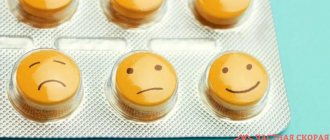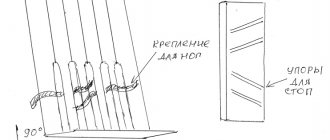pharmachologic effect
The main substance of the drug is a non-essential amino acid. It is a mediator of nervous excitation. Thanks to its composition, Glycine has a sedative effect, improves metabolic processes in brain tissue, and increases the body's resistance to various damaging factors, including hypoxia.
Pharmacodynamics
Glycine is a regulator of metabolic processes. The drug increases brain activity and relieves the severity of symptoms of psycho-emotional stress. The drug normalizes sleep, improves mood, and alleviates the symptoms of menopause. Glycine is used as part of complex therapy to treat withdrawal symptoms. The drug reduces the severity of the consequences of traumatic brain injuries and cerebrovascular accidents.
Pharmacokinetics
Glycine penetrates into most biological fluids of the body. As a result of the metabolism of the drug, water and carbon dioxide are formed. Therefore, Glycine does not accumulate in tissues.
Why do babies need the drug?
A neurologist prescribes glycine to newborn children if:
- they suffered birth trauma,
- During their birth, hypoxia (lack of oxygen) occurred.
If the dose of the drug recommended by the doctor is followed, it copes well with neurological disorders (for example, perinatal encephalopathy) and improves its neurological condition, including eliminating hypertonicity of the limbs, tremor and correcting behavior.
The child will not be at risk if the exact recommended doses are used if Glycine is prescribed for a good reason, and not simply for the prevention of nervous disorders.
Indications for use
The main indications for the use of Glycine include:
- prolonged psycho-emotional stress;
- decreased memory and attention;
- consequences of ischemic or hemorrhagic stroke;
- insomnia;
- neuroses;
- encephalopathy of any origin;
- treatment of withdrawal syndrome (hangover) due to alcohol intoxication;
- vegetative-vascular dystonia;
- relief of clinical symptoms during menopause;
- tension headache and dizziness;
- complex therapy of arterial hypertension.
The use of Glycine during breastfeeding is permitted under strict indications and under medical supervision.
The drug is used sublingually (under the tongue) or buccally (between the upper lip and gum). The dosage of the drug is 100 mg. Glycine is prescribed 1 tablet 2-3 times a day. Before using the drug, it is recommended to consult a doctor to determine the required dose, frequency of administration and course duration.
Dosages and use: doctors' opinion
For newborn infants, the usual method of oral administration or dissolving Glycine tablets under the tongue is not suitable; there are other options for using the medicine:
- The ground part of the tablet is placed in a small amount of water and stirred. The child drinks an aqueous solution from a spoon or pipette.
- A solution also formed by crushing the required amount of medicine (in this case, tablets). Next, the resulting mixture (rather an aqueous solution) is poured into a bottle, if the practice of artificial feeding is used and the child is not afraid of this method of introducing liquid inside (unlike those babies who are accustomed to breastfeeding).
- You can dip the tip of the pacifier into the powder , ground from a tablet, and give it to the child, performing the action as a usual and familiar gesture (ritual) for a small child.
The dose for newborns is from a quarter (0.25 mg) to a half tablet (0.5 ml).
Glycine is taken two or three times a day for one month. According to pediatricians, in the absence of sensitivity to the drug, its use does not pose any threat to the child’s health.
The main thing is to monitor the baby’s condition after the first and second doses. If an allergic reaction occurs, stop using the drug immediately.
But for those children who tolerate the medicine well, it is possible (according to the latest data) to increase the current portion as needed and, of course, as prescribed by the doctor, in some cases up to two or three times.
Glycine overdose
Symptoms of a Glycine overdose occur when the drug is taken incorrectly, as well as when it is consumed simultaneously with alcoholic beverages. In order for signs of drug intoxication to appear, a single dose of 15-20 tablets of the drug is required. The main manifestations of overdose include:
- drowsiness;
- dizziness;
- loss of consciousness;
- vomit;
- nausea;
- stool instability;
- dry mouth;
- sopor;
- bronchospasm;
- anaphylactic shock.
First aid before the doctor arrives is to lavage the stomach. To do this, you need to drink 1.5 -2 liters of water and press on the root of the tongue. If the medicine was taken a long time ago, then in order to alleviate the condition, it is recommended to drink an absorbent drug. Severe forms of Glycine overdose require immediate hospitalization. In the hospital, the severity of the condition is determined and appropriate detoxification therapy is carried out.
Interaction
The effect of taking Glycine largely depends on what medications it interacts with. The combined use of Glycine with sedatives of herbal origin is permitted. This combination is used in the complex treatment of anxiety disorders and sleep disorders.
The interaction of Glycine with other nootropic drugs leads to an increased sedative effect. The combined use of these drugs is acceptable.
When Glycine is prescribed simultaneously with drugs from the tranquilizer group, the inhibition of the central nervous system is additive. This combination of drugs is acceptable in the treatment of neuroses, sleep disorders, and psycho-emotional disorders. Dosages are determined by the attending physician based on the disease and the severity of its condition.
The combined use of Glycine with neuroleptics, antidepressants and anticonvulsants reduces the severity of their side effects.
Briefly about the main thing
Glycine, as an amino acid, is a neurotransmitter for both newborns and adults, so its intake improves processes in the nerve cells of a person of any age.
That is why when infants take the drug, they experience normalization of inhibition processes in the central nervous system.
Glycine, also called (according to its chemical composition) aminoacetic acid, is produced in the body of a healthy person in certain quantities. This drug has neurometabolic, neuroprojective, and antioxidant effects.
Despite the fact that the drug does not accumulate in the body and does not have a negative effect, only a neurologist can prescribe it, and it cannot be used for prevention or self-medication.
Glycine analogs
In cases where the use of Glycine is impossible for some reason, it is recommended to replace it with drugs with similar effects. These include Afobazol, Tenoten, Noopept, Valerian, Mexidol, Picamilon, Ginkum, Piracetam, Novopassit, Divaza, Eltacin.
Which is better: Glycine or Afobazole?
Afobazole is an anxiolytic drug. The drug reduces the manifestations of anxiety syndrome and normalizes sleep. The active ingredient Afobazole is morpholinoethylthioethoxybenzimidazole dihydrochloride. Despite the fact that the drug was specially developed to reduce the excitability of the nervous system, it does not have a hypersedative effect. Taking Afobazole does not cause drowsiness or reduce concentration. Indications for taking Afobazole include:
- sleep disorders;
- increased anxiety;
- irritability;
- various diseases, including systemic lupus erythematosus, cerebrovascular disease, dementia of various origins, irritable bowel syndrome and other somatic pathologies;
- premenstrual syndrome;
- the need to remove alcohol and nicotine from the body.
Afobazole and Glycine have a similar mechanism of action. Both drugs are available in tablet form. Afobazole is taken with a sufficient amount of water, and Glycine is placed under the tongue. The differences between drugs lie in the active ingredients. Afobazole is a chemical, Glycine is an amino acid natural to the brain. Therefore, taking Glycine is allowed during pregnancy, unlike Afobazole. To enhance the effect of treating anxiety disorders, co-prescription of medications is indicated.
Which is better: Glycine or Tenoten?
Tenoten is a nootropic drug. It has antiamnestic, antidepressant, antiasthenic, antihypoxic and neuroprotective effects. The active substance of Tenoten is affinity purified antibodies to the brain-specific protein S-100. The main indications for the use of the drug include:
- stress;
- neuroses and neurosis-like conditions;
- memory impairment;
- emotional lability;
- encephalopathy;
- organic diseases of the central nervous system.
Glycine and Tenoten belong to the group of nootropic and anxiolytic drugs. Their action is aimed at activating brain activity. The drugs are available in the form of tablets that are taken sublingually. Tenoten is indicated for increased psycho-emotional tension. To improve memory and attention, it is better to choose Glycine. This drug is also suitable for use during pregnancy. Taking medications together is indicated when prescribing complex therapy.
Which is better: Glycine or Noopept?
Another representative of the group of nootropic drugs is Noopept. The drug has a neuroprotective, antioxidant and vegetative-normalizing effect. The active substance of the drug is N-phenylacetyl-L-prolylglycine ethyl ester. Increases the resistance of brain tissue to various damages. With the development of ischemic stroke, Noopept is prescribed to reduce the volume of the lesion. The drug improves the rheological properties of blood, restores memory and cognitive functions of the brain. Indications for prescribing Noopept are:
- memory and attention disorder;
- cerebrovascular accident;
- encephalopathy;
- recovery period after being in a coma;
- consequences of traumatic brain injury.
Glycine and Noopept help improve brain activity and restore memory. Both drugs are available in tablet form. Glycine is used sublingually. Noopept tablets are taken orally with enough water.
Which is better: Glycine or Valerian?
Valerian is a sedative of plant origin. Has a sedative and antispasmodic effect. The active ingredients of the drug are isovaleric acid and borneol ester. Thanks to its properties, the drug helps normalize sleep and stool, reduces the severity of spasms, and improves cardiac activity. Taking Valerian reduces the risk of migraines and epileptic seizures.
The main indications for taking Valerian include:
- sleep disturbance;
- tachycardia of any origin;
- emotional lability;
- neurodermatitis;
- migraine-type headache;
- complex therapy of arterial hypertension;
- menopause;
- increased gas formation;
- constipation;
- epilepsy attacks.
Valerian has restrictions on its use. These include the first trimester of pregnancy, individual intolerance to the components of the drug, depression and low blood pressure. Valerian and Glycine normalize sleep and reduce the severity of anxiety. One of the differences between the drugs is their composition. The active component of Glycine is an amino acid, Valerian is a completely herbal preparation. Taking Valerian can be accompanied by a large number of side effects. Before using medications, it is recommended to consult a doctor. The specialist will conduct the necessary diagnostics and, based on the results obtained, choose a medicine.
Which is better: Glycine or Mexidol?
Mexidol is an antioxidant drug. The active substance of the drug is ethylmethylhydroxypyridine succinate. Mexidol increases the body's resistance to various damaging factors, helps normalize blood microcirculation in the brain, and reduces the severity of alcohol intoxication. The drug improves the rheological properties of blood, stabilizes the processes of wakefulness and sleep. Indications for prescribing Mexidol are:
- consequences of traumatic brain injury;
- neuroses and neurosis-like conditions;
- withdrawal syndrome;
- vegetative dystonia;
- cardiac ischemia;
- cerebrovascular pathology;
- cognitive impairment;
- consequences of acute cerebrovascular accidents.
Glycine and Mexidol have a sedative and nootropic effect. Helps normalize brain activity, restore sleep and reduce the severity of anxiety. The differences between the drugs are in the form of release, active substances and additional properties. Glycine is produced in the form of tablets for oral administration. Mexidol is available in the form of tablets, injection solution and toothpaste. Glycine contains an amino acid that is natural to the brain. The active substance of Mexidol is ethylmethylhydroxypyridine succinate.
Which is better: Glycine or Picamilon?
Picamilon is a drug from the nootropic group. It has an antioxidant, vasodilator and sedative effect. The active substance of the drug is nicotinoyl gamma-aminobutyric acid. Picamilon improves the processes of memory, thinking and attention. Thanks to its sedative effect, the medicine helps reduce the severity of anxiety and normalize sleep. Indications for the use of Picamilon are:
- diseases of the brain of vascular, inflammatory or traumatic origin;
- depression;
- consequences of alcohol abuse;
- migraine-type headache;
- excessive mental and physical stress;
- prolonged stress;
- conditions accompanied by nervous exhaustion;
- open angle glaucoma.
Unlike Glycine, Picamilon has a more pronounced effect. However, its side effects appear much more often and to a greater extent. Glycine has a gradual effect, noticeable after a course of administration. The combined use of drugs is allowed. They complement each other's action. This combination of drugs is actively used by doctors for adolescents during periods of mental overload.
Which is better: Glycine or Ginkoum?
Ginkoum is a sedative of plant origin. The active substance of the drug is ginkgo biloba extract. The action of Ginkoum is associated with improved blood microcirculation in the brain and a positive effect on memory. A course of taking the drug has an antioxidant effect, reducing the risk of developing cancer. The main indications for the use of the drug are:
- cerebrovascular accident;
- dizziness;
- noise in ears;
- cerebrovascular diseases;
- weakness, increased fatigue;
- migraine-type headache;
- high blood pressure;
- encephalopathy of various origins;
- a condition caused by brain hypoxia.
Glycine and Ginkoum are nootropic drugs of plant origin. The range of their actions and indications is largely similar. Glycine is available in tablet form. Ginkoum is produced in the form of capsules for oral administration. The drugs are well tolerated. Before use, it is recommended to consult a doctor to determine the dosage, frequency of administration and course duration.
Which is better: Glycine or Piracetam?
Piracetam is a nootropic drug. It is a cyclic derivative of gamma-aminobutyric acid. The active ingredient of the drug is piracetam. Thanks to its properties, the drug increases the body’s resistance to various toxic substances, minimizes the risk of developing seizures, helps improve the functional activity of the brain, and activates its metabolic processes. The main indications for the use of Piracetam include:
- memory impairments of various origins;
- dementia;
- cortical myoclonus;
- cerebrovascular accidents;
- complex therapy of alcohol intoxication;
- chronic fatigue;
- coma;
- neurasthenia.
Both drugs have a nootropic effect. Glycine is produced in the form of tablets for oral administration. Piracetam is produced in the form of tablets and solution for injection.
Which is better: Glycine or Novopassit?
Novopassit is one of the sedative medicines based on herbal components. The drug has no anti-anxiety and sedative effect. Novopassit helps reduce the severity of anxiety, normalizes sleep, and eliminates tension headaches. Due to its properties, the drug is used to relieve premenstrual syndrome and menopausal symptoms. Novopassit is prescribed for the following conditions:
- migraine;
- conditions accompanied by constant nervous tension;
- neuroses and neurosis-like conditions;
- tension headache;
- sleep disturbance;
- menopause;
- psychogenic itching;
- irritable bowel syndrome.
Both drugs affect the central nervous system. They have a minimal number of contraindications. Novopassit is available in the form of tablets and solution for oral administration. Glycine is produced in the form of tablets for sublingual use. Novopassit contains plant components in combination with semi-synthetic guaifenesin. Glycine is an amino acid that is naturally found in the brain.
Which is better: Glycine or Divaza?
A representative of the group of nootropic drugs is Divaza. The drug has neuroprotective, anxiolytic, antidepressant, antioxidant, neurometabolic and sedative effects. Divaza helps to increase the brain's resistance to the effects of toxic substances, as well as to hypoxia. The medication improves cerebral circulation, memory, thinking and attention. The active ingredients of the drug are antibodies to the brain-specific protein S-100 and antibodies to endothelial NO synthase. Indications for the use of Divaza include:
- ischemic stroke;
- memory and attention disorder;
- emotional lability;
- consequences of traumatic brain injury;
- symptoms of vegetative-vascular dystonia;
- neuroinfections;
- long-term stress loads.
Divaza and Glycine are used to improve brain activity, stabilize the emotional background, and restore cognitive functions of the brain. The differences between the drugs lie in the mechanisms of action and active substances. Divaza contains antibodies to the brain-specific protein S-100 and antibodies to endothelial NO synthase. Glycine is a naturally occurring amino acid in the brain. Divaza promotes the regeneration of brain cells, increases the speed of transmission of nerve impulses and improves memory. Glycine reduces the excitability of brain cells, normalizes sleep and restores memory. Taking Divaza is contraindicated for persons under 18 years of age. Glycine is approved for use from school age.
Which is better: Glycine or Eltacin?
Eltacin is an antioxidant combination drug. The drug contains glycine, L-glutamic acid and L-cysteine. Eltacin helps normalize metabolic processes in the body, increases its resistance to negative factors and hypoxia, increases endurance and shortens the recovery period after intense physical activity. Indications for prescribing the drug are:
- autonomic dysfunction;
- chronic overexertion;
- alcohol intoxication;
- chronic heart failure;
- recovery after prolonged physical activity.
Glycine and Eltacin have a similar composition, mechanism of action and effects. Thanks to the enhanced composition, Eltacin has more pronounced properties. Concomitant use of drugs is prohibited. This is due to the possibility of glycine overdose. The dosage, frequency of administration and duration of the course should be determined by the doctor.
Why do babies need glycine?
Glycine is an aminoacetic acid that is produced by the human body itself. It participates in the processes of protein and enzyme synthesis and regulates metabolic processes. When it enters the body through the gastrointestinal tract, glycine enters the liver and is used for the needs of protein synthesis.
If the drug is absorbed under the tongue, then it enters the brain through the bloodstream, where it affects its receptors.
Glycine acts as an inhibitory neurotransmitter, removing increased excitation of the central nervous system.
Another important property of glycine is antioxidant. It is capable of significantly neutralizing the effect of toxic substances on the human body.
Glycine for infants has the following properties:
- Normalizes metabolism in nerve cells.
- Helps to more easily endure the pain experienced after passing through the birth canal of the mother.
- Calms the baby, makes it easier for him to fall asleep and improves the quality of sleep.
- Helps remove toxins that may have entered the baby's body.
- Reduces the effects of ischemic brain damage.
- Helps develop neural connections between brain cells, promoting faster adaptation to the external environment.
- Reduces increased muscle tone.
- Participates in the formation of immunity.
It often happens that the body’s own synthesis of glycine is not enough to meet the needs of the child’s body. Or there is too little of it in the food we consume, such as breast milk. In this case, an additional dose of the drug is prescribed in the form of tablets.
Doctors can prescribe glycine to children starting from newborn age. This is done for various reasons, but all indications for use are combined into one - neurological - group.
Indications for the use of glycine are:
- birth trauma (intracranial hemorrhage, cephalohematoma);
- hypoxic damage to the central nervous system;
- perinatal encephalopathy;
- hydrocephalic syndrome;
- muscle hypertonicity;
- tremor (shaking) of the limbs, head, chin;
- increased nervous excitability;
- sleep disorders.
Despite the fact that glycine has virtually no side effects and does not manifest itself in any way in overdose, it should be given to infants only as prescribed by a pediatric neurologist or pediatrician. Self-treatment of infants is prohibited.
Glycine during pregnancy and lactation
There are still no studies confirming the absolute safety of the drug for pregnant women. Therefore, its use during pregnancy is strictly indicated when indicated and under the supervision of a doctor. The dosage of the drug is selected individually based on the characteristics of the woman’s body.
The use of Glycine during lactation is permitted. The drug has a mild effect on the body. A small amount of the medicine passes into breast milk. The permitted dosage is selected individually for each woman.
When is glycine required?
In addition to situations where a pediatrician advises parents of a hyperactive or whiny, restless baby to drink glycine to prevent anxiety and nervousness, there are a number of reasons for which glycine must be prescribed to an infant:
- In the presence of birth injuries;
- If the child suffered hypoxia at birth;
- For congenital encephalopathitis;
- With increased tone of the body and limbs in the first weeks or months of life;
- With tremors of the limbs, head;
- For psychobehavioral disorders: attention, sleep, inability to focus.
It is noteworthy that, despite the safety of the drug for newborns, the instructions for use do not recommend the use of glycine for newborns without a medical prescription and obvious reasons for taking it.






